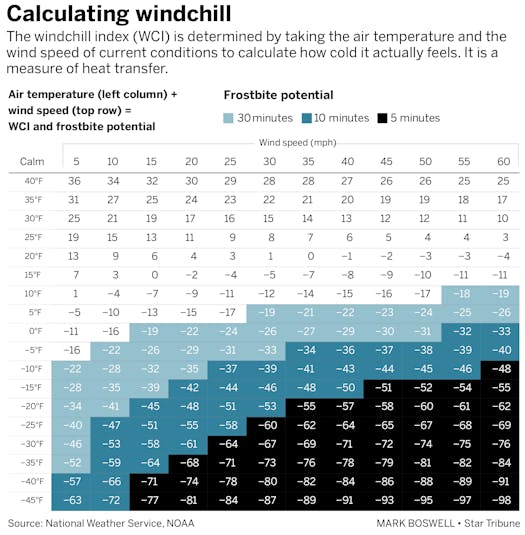Brrrrrrr.
January is living up to its claim as the coldest month of the year, already delivering 11 nights of below-zero temperatures so far in the Twin Cities, with the coldest night of the year on tap Tuesday.
Hearty Minnesotans may simply want to shrug the arctic chill, but don't underestimate the challenges and dangers that negative temperatures bring, said Dr. Thomas Masters, a physician in Hennepin County Medical Center's department of emergency medicine.
"Cold does not care how strong you are," he said.
With readings set to sink to near minus 18 Tuesday, and the cold snap showing no signs of abating — except for a slight break Wednesday — Michelin Man attire is in order, he said.
"Your mother was right: Dress in layers," Masters said.
- He recommends:
Wearing hats, heavy gloves, scarves, wool socks and even COVID facemasks are essential for keeping Jack Frost from nipping at your toes, nose, fingers and ears, extremities that can freeze in a matter of minutes when it's colder than in your freezer. - Limiting time outside. HCMC has already treated 54 patients for frostbite, which can lead to nerve and bone damage and, in severe cases, death. That's up from 50 in all of last winter, Masters said.
"Keep things bundled up," he said. "Listen to your body. If it is hurting or losing sensation, it's time to come in from the cold."
Motorists can unexpectedly find themselves stuck in the elements for hours if their vehicle breaks down or roads become impassible, as we saw when hundreds of drivers became stuck on Interstate 95 on the East Coast earlier this month.
Maintenance is key, said Meredith Mitts with AAA Minnesota-Iowa.
Properly working battery, brakes, belts, hoses, oil, fluids, tires and other vehicle systems can help prevent inconvenient and costly breakdowns, whether drivers are on a long road trip or a dash to the mall, she said.
AAA's other tips:
- Keep emergency supplies in the vehicle, including a cellphone, boots, gloves, blanket, an alternate heat source, shovel and first-aid kit. Having snacks on hand is a good idea, too.
- If stranded, stay with the vehicle. If the engine starts, run it only long enough to keep warm. Make sure the exhaust pipe is free of snow. It's also advised to keep the fuel tank at least half full to avoid the fuel-line freezing and to provide extra fuel for running the engine if stranded.
Thinking of warming up the car? It's totally unnecessary, even on the most frigid days, said Douglas Longman, manager of engine research with the U.S. Department of Energy's Argonne National Laboratory. Modern cars have electronic fuel injection, so drivers need to let their vehicles run for only up to 30 seconds before pulling out of the driveway.
Once on the roads, here are driving tips from the Minnesota Department of Transportation:
- Black ice is a real danger as chemicals used to melt ice lose their effectiveness in brutally cold conditions, so slow down and be prepared for changing road conditions.
- Leave extra car lengths between other drivers and plows.
- Turn on headlights.
- Wear your seat belt and don't drive distracted.
Timing is everything for transit riders. Here's advice from Metro Transit:
- Use the agency's app to track bus or train arrival times to minimize time standing at stops.
- Remain on curbs and platforms until vehicles come to a complete stop.
- Be visible to approaching buses by wearing light-colored clothing. Signal your presence with a small blinker light or flashlight.
- Use handrails when boarding and alighting, as steps can become slippery.
Or you could just escape to sunny Miami for a few days. Cheap deals abound, even for this weekend.

Extreme fire risk for the Twin Cities metro - warm and dry bias to linger into late October

Welcome to 'Aug-tober': Dry with a few 80s into mid-October

19th day of 80s in September but temperatures cool off a bit on Tuesday

Welcome to the driest, warmest September on record



